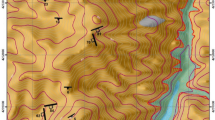Abstract
Precambrian layered rocks consisting of quartzites, phyllites and metagreywackes of the Aravallis having a large variation in thickness, petrographic and strength characteristics constitute the foundation of the Kadana dam on the River Mahi, Gujarat, India. The nearly vertical formations are grouped into blocks and are considered as a composite rock mass system. Model simulation techniques were utilized to investigate the stress-strain characteristics of this composite rock mass. A relation has been established between strength reduction and the presence of weaker components and the inclined discontinuities in the composite. The experimentally determined values of the uniaxial compressive strength and the static modulus of elasticity of the models are compared with their values obtained by theoretical calculations and the ratio is termed “composit efficiency”. The “composite efficiency” when multiplied by those theoretical values of the prototype composite yield the estimated composite values of compressive strength and elastic modulus of the prototype. This method has shown that the strength deformation conditions of foundation rocks of a complex nature, differing both in lithology and structure, can reasonably be predìcted from the model simulation studies. Such data are of immense value in the design of an engineering structure.
Résumé
La fondation du barrage de Kadana, sur la rivière Mahi, dans le Gujarat (Inde) est constituée de roches précambriennes disposées en bancs (quartzites, phyllites et métagreywackes) et présentant des épaisseurs ainsi que des caractéristiques pétrographiques et de résistance très variables. Les formations pratiquement verticales sont regroupées par «blocs» et sont considérées comme un ensemble de masses rocheuses. Les techniques de modélisation ont été utilisées pour étudier les relations contraintes-déformations de cet ensemble rocheux composite. Une relation a été mise en évidence entre l'abaissement de la résistance et la présence de composants nocifs et de discontinuités dans la masse. Les valeurs expérimentales de résistance à la compression simple et du module statique d'élasticité des modèles sont comparées aux valeurs obtenues par le calcul théorique et le rapport est appelé «efficacité composite». Cette méthode de simulation sur modèles permet de prévoir de façon raisonnable les conditions de contraintes-déformations de massifs rocheux complexes, différant à la fois par leur lithologie et leur structure. De telles données sont d'un très grand intérêt lors de la conception d'ouvrages de génie civil.
Similar content being viewed by others
References
DEERE D.U., MILLER R.D. (1966): Engineering classification and index properties for intact rock. Technical Report, No. AFWL-TR-65-116, Airforce Weapons Laboratory, Kirtland, Airforce Base, New Mexico.
EINSTEIN H.H. and HIRSCHFELD R.C. (1973): Model studies on mechanics of jointed rock. Proceedings paper 9610. Journal of the Soil Mechanics and Foundation Division, American Society of Civil Engineers,99, SM-3, 229.
FUMAGALLI E. (1969): Model simulation of rock mechanics problems. Rock Mechanics in Engineering Practice. Edited by K.G. Stagg and O.C. Zienkiewics, John Willey, London, 353–384.
HANSEN T.C. (1960): Creep and stress relaxation of concrete. Handlinger—Proceedings NR-31 Swedish cement and concre te Research Institute—Stockholm, 33–44.
KELLY A. (1966): Theory of strengthening of metals. Composite materials-lectures delivered at the Institution of Metallurgical Refresher course, 3–25.
LUBIN G. (1979): Handbook of fiberglass and advanced plastics composites. Van Nostrand Reinhold Co., New York, 185 p.
PARTHASARATHY A., SHAH S.D. and LIMAYE R.C. (1974): Certain engineering geological studies pertaining to Kadan region, Gujarat, India. Proceedings ofII Congress of the International Association of Engineering Geology, Sao Paulo, Brazil, VI-31, 1–10.
Public Works Department (Gujarat, India) (1973): Kadana Project Manual (unpublished).
SHAH S.D. (1976): Engineering Geological Studies of Kadana Dam Region, Panchmahals District, Gujarat, Ph. D. Thesis, I.I.T. Bombay (Unpublished).
Author information
Authors and Affiliations
Rights and permissions
About this article
Cite this article
Shah, S.D., Parthasarathy, A. & Limaye, R.C. Geomechanical model simulation for the varied rock formations of the Kadana dam foundation, Gujarat, India. Bulletin of the International Association of Engineering Geology 31, 123–129 (1985). https://doi.org/10.1007/BF02594755
Published:
Issue Date:
DOI: https://doi.org/10.1007/BF02594755




